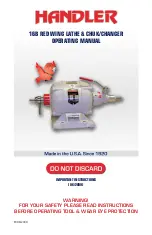
Description of the pressure die assembly
The pressure die is shown in the 2 pictures below. It is sometimes referred to as a ‘followbar’. It constrains
the outside of the tube while bending. It is made up of 2 inserts and the backing block. The inserts are cast and
machined from a special, scratch and wear resistant, metal alloy. The inserts are relatively self lubricating but
are considered as consumable. They are NOT aluminum. Their typical life span is 1,000s of bends when using
clean tubing.
In the left side picture you can see the left insert is in line with the backing block and the right insert is angled.
The angled insert is the trailing insert and will always be closest to the u-strap during bending. It rides where the
tube has already been bent, thus helping to minimize the amount of flattening on the outside of the bend. It is
computed to within 1/1000th of a degree at the time of manufacture to produce the best bend conditions for the
size of tubing and the bend radius. Therefore, the pressure die must be installed into the bender correctly in order
to take advantage of this design feature or you will experience poor bend quality.
In the right side picture you can see the bottom of the pressure die. The roll pin will hold the pressure die up
when the pressure screw is retracted. It must be adjusted so that the insert’s grooves are 1/16” or so below the
forming die’s groove when the tube is not loaded. This will allow the pressure die to rise slightly and level itself
when the toggle is advanced into the bending position.
The standard tool plate has 2 pin hole locations. This allows the amount of rear insert force to be tailored to
the tube being bent, thus producing a better quality of bend.
Installing the pressure die into the bender
If you examine the pressure die’s top surface you will notice the engraved word TOP and usually a circle and
tool plate outline. This engraving illustrates which tool plate is needed and what hole to place the 1” pin into.
Place the pressure die into the tool plate and align it with the engraved markings aligned with the tool plate’s
outline. The lower left picture shows a pressure die designed for the standard 2 hole tool plate. The 1” pin
obviously goes into the hole on the right side of the photo. Always be very careful to ensure the 1” pin as been
completely seated all the way down to the roll pin.
The 3” tube pressure die shown below right is designed for a 1 hole tool plate as can be seen by the engraving.
Pressure
die insert
Pressure die top view
Pressure die bottom view
Roll pin
Engraved phantom
hole circle and TOP
indicator
Backing
block
A pressure die installed into a two hole
tool plate.
The engraved outlines
show how to load the
pressure die
Page 10
Angled insert
A 3” tube pressure die. It is designed for a one hole tool
plate as can be seen by the engraving.





























